Not so rough-to-make quick puff pastry
Let's play around with the dough for sweet or savory pastry riffs
Hello! Hello!
Priscilla Martel is my friend and my kitchen hero. If she ever decided to stop teaching and writing or creating great recipes or producing a terrific newsletter (sign up for it now!), she could start a helpline and I’d put that number at the top of my “favorites.” In the meantime, I count myself lucky that she allows me to pepper her with questions. Michael, too — Priscilla and her partner Charlie Van Over are ace bread bakers, and they can spot an under-proofed bread, a loaf that lacks enough hydration or one that wasn’t properly shaped at 10 paces.
I’ve written about Priscilla before. When I fell in love with her hard-boiled eggs with homemade mayonnaise, the classic French dish called oeuf mayonnaise, I asked if we could make the recipe together for The New York Times. I’ve been whipping up mayo ever since. (The other night, I made saffron mayonnaise to spoon into fish soup — no biggy.)
Now, thanks again to Priscilla, I’m making rough puff pastry — aka blitz or cheater’s puff. Even on weekdays. In fact, after I watched Priscilla make the pastry in her kitchen — and turn some of it into a lovely apple tart — I went home and instantly did the same. I was so tickled with myself (I felt like a kid who’d just learned to ride a bike) and Michael was so happy (he loves apple tart). Bonus: there’s enough leftover dough in the freezer for another tart — or a potpie or some turnovers or a pile of mustard bâtons, which I always made with store-bought puff pastry in the before times.
Quick Puff Pastry for Bake and Tellers and Every Other Baker, Too
Quick Puff is the recipe-of-the-month for the Bake and Tell bakers, and a recipe every baker will want in their bag of tricks. And really, it is a trick. You make the dough by hand — a process that’s fun and takes under 20 minutes — pop it into the fridge for an hour and then, presto! It’s ready to use.
Like its grander sibling, puff pastry, quick puff is a laminated dough, meaning that it’s layered with butter. It’s rolled out and folded over on itself several times so that the butter in the dough — and there’s a lot of butter! — is distributed in such a way that when it melts in the oven, it creates steam and endless layers. Rough puff requires half as many roll-outs and turns as classic puff and it doesn’t produce as many layers, but what it does produce is fabulously delicious and pretty darn impressive.
Once You’ve Got the Dough, Get Baking
Priscilla and I each made very simple apple tarts with our dough — let me know in the comments if you’d like the recipe in a future post — but there are so many things to do with it. It’s the base of almost limitless play-aroundables. For starters, you might want to riff on:
Mustard Bâtons — the recipe is in AROUND MY FRENCH TABLE, but you can find it in other places
Cheese Straws — here’s a basic recipe for them, but once you know how to twist them, you can get playing
Baked Brie — take a look at what Jenn Segal does
Here’s PureWow with 30 — count ’em — ideas to get you started
Puff away and show me what you do! I’ll be popping into BAKE AND TELL to see what’s on the rise there, but you can always show me your dough — and anything else — on Instagram or Facebook. And you can always leave a comment on this post.
Some of the links in this post may be affiliate links. As an Amazon Associate, I might earn a little flour-and-sugar money if you make a qualifying purchase after clicking on a link, which I promise to use while creating more stories like this. Thanks for your support.
QUICK PUFF PASTRY
Taught to me by Priscilla Martel (adapted from Nick Malgieri’s Perfect Pastry and On Baking by Labensky, Martel and Van Damme)
GOOD TO KNOW BEFORE YOU START
Measuring: The recipe was tested to be made by weight. To get the best results, please weigh everything. I’ve included volume (cup) measures for the scaleless - they’re very close, but they’re approximate.
The flour: Priscilla and I consider King Arthur All-Purpose Flour our house flour. It’s what she used to make the dough along with some King Arthur Cake Flour and it’s what I used when I made it chez me.
Temperature: As with so many pastry doughs, cold is the key to success. The butter should be cold; the water should be cold; and the dough should remain pretty chill as you’re working it. If the dough gets warm, you can give it a moment in the fridge, but you probably won’t have to — everything moves quickly here.
Scraps: Hold on to your scraps! Brush them with a little butter, sprinkle with sugar or salt and then, depending on whether you’re swinging sweet or savory, you can season the tops with spice or herbs. Bake and nibble happily. You can also stack up your scraps (for good puff, make sure the butter streaks are all running in the same direction), reroll them and make snacks from them.
Makes about 1 pound 4 ounces (590 grams)
INGREDIENTS
190 grams (1 1/3 cups) all-purpose flour (see above)
38 grams (1/4 cup) cake flour (see above)
3 grams (1/2 teaspoon) fine sea salt
240 grams (16 tablespoons) very cold unsalted butter (see above), divided
120 ml (1/2 cup) very cold water
DIRECTIONS
Place the all-purpose flour in a large bowl and sift (or strain) the cake flour over it; add the salt. Thoroughly stir to blend.
Slice 30 grams of the butter into thin pieces and toss the pieces into the bowl with the flour. Cut the remaining butter into 1/2-inch cubes and keep in the fridge.
Rub the slices of butter into the flour with your hands, tossing and squeezing in the butter until no visible pieces remain. (The flour will look like meal. Scoop under the flour and watch it flow through your hands — you shouldn’t find any noticeable pieces of butter.)
Add the cubes of cold butter to the bowl and toss to separate and distribute the butter. Do not rub the cubes of butter into the flour. Make a well in the flour-and-butter mixture and add the water.
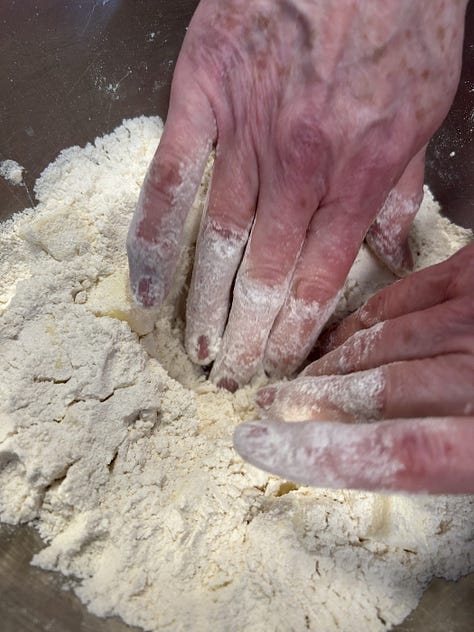


Toss gently with a flexible spatula until the dough is evenly moistened. Add drops of water, if necessary, to complete the moistening. Press and squeeze the dough to form a rough cylinder.
Lightly flour the work surface and the dough. Using the palm of your hand, press down on the dough to shape it into a rough rectangle.

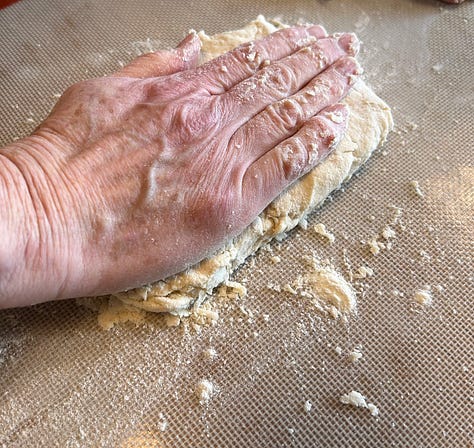

Roll the dough back and forth until it forms a rectangle about 1/2-inch thick. (Priscilla rolled hers on a baking mat and used a silicone rolling pin with handles. I rolled mine on a granite countertop using a French pin - both worked perfectly.) Turn the dough over, so that you roll it on both sides — the pieces of butter will be visible, and you’ll see them stretch into streaks — and roll until the dough is about 4 inches by 12 inches. (The standard is 6-x-18 inches, but smaller is fine — the principle is to have the length be about three times the width. That said, this dough is very forgiving.)
Fold both ends of the dough in toward the center, then fold one side of the dough over the other to make a double book fold. You’ll have a stack of four layers. Position the package of dough so that the “book spine” is on your left. (Actually — the spine can be anywhere — you just want to be sure that you always return it to its original position.)
Lightly flour the work surface and the dough and repeat the rolling as before. Roll the dough along its length as before — rolling both sides — and then roll several times along its width to form a rectangle, just as you did before. Fold the dough into the double book fold as before.
Repeat the process once more, so that the dough is turned a total of three times. (The dough gets smoother and smoother — although it’ll never win a beauty contest. You’ll still be able to see the butter and that’s perfect!)
Wrap the dough well in plastic and chill for at least 1 hour before using.
STORING: The dough can be refrigerated about 3 days or frozen up to 1 month. Defrost frozen dough in the refrigerator overnight before using.
📚 You can find more recipes in my latest book BAKING WITH DORIE.
👋 Say hello and share what you're making on Facebook and Instagram.





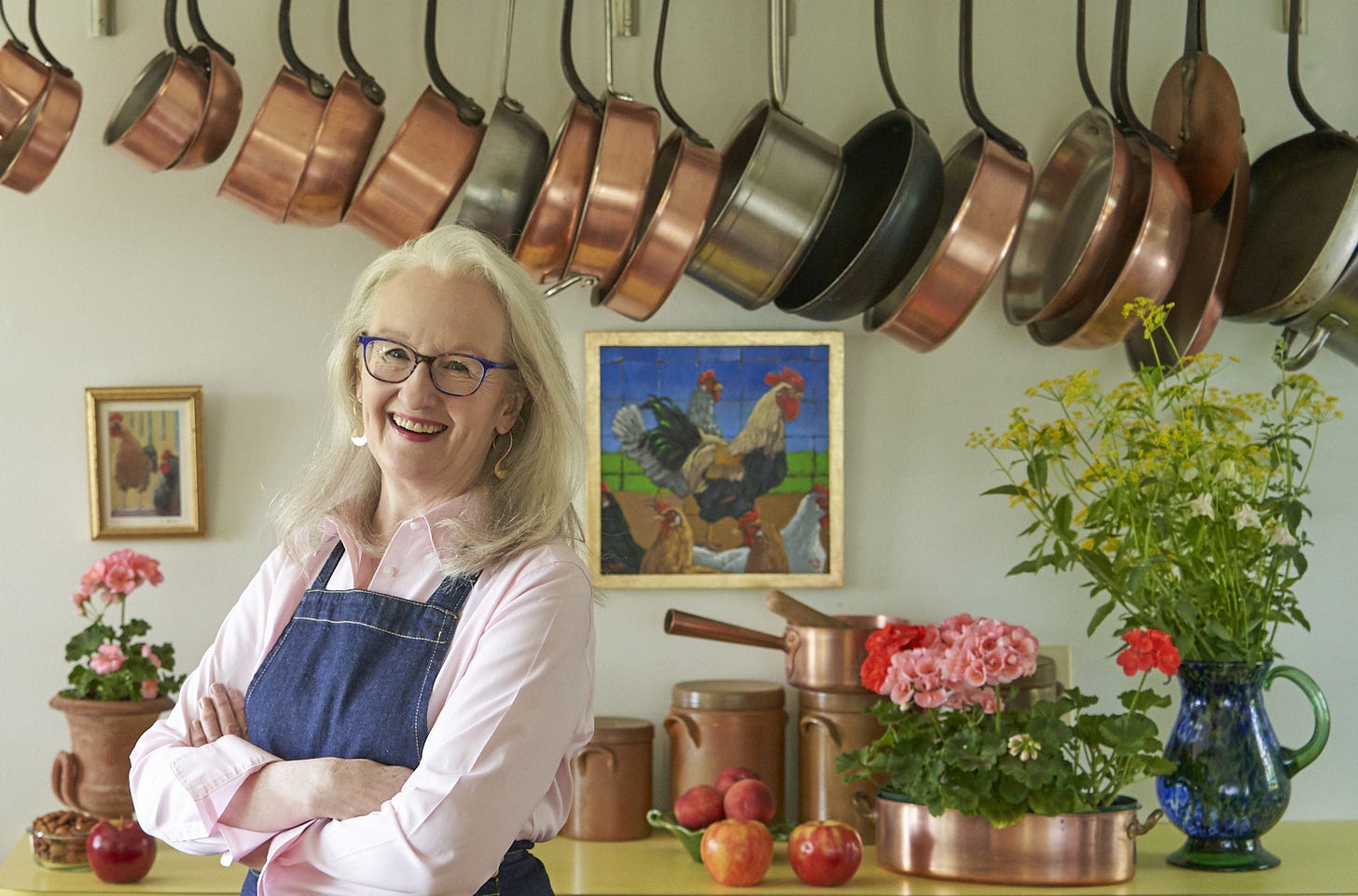






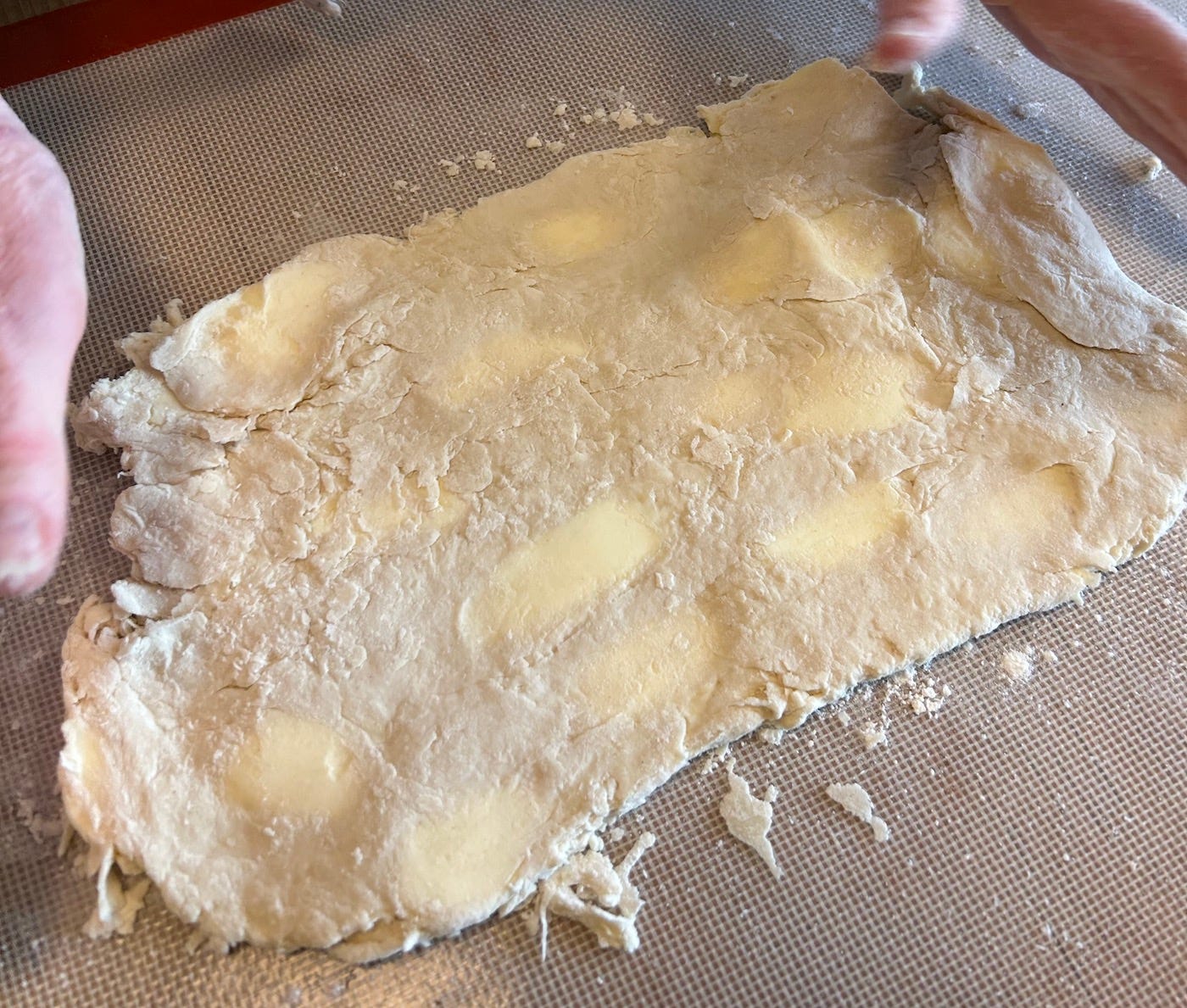

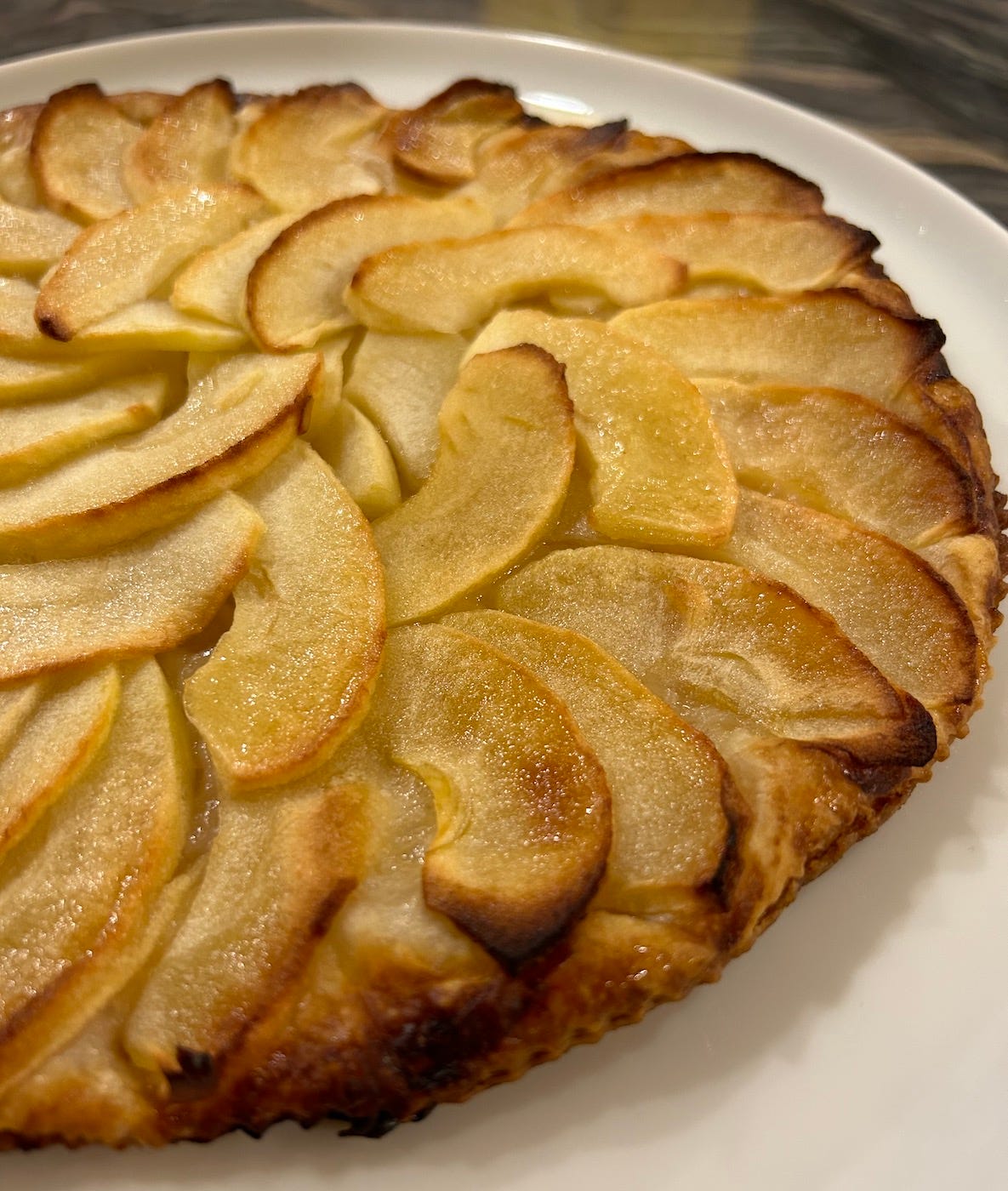

Yes please for the apple tart recipe made with this puff pastry! Thank you.
Please, please a recipe for gluten-free pasta or puff pastry